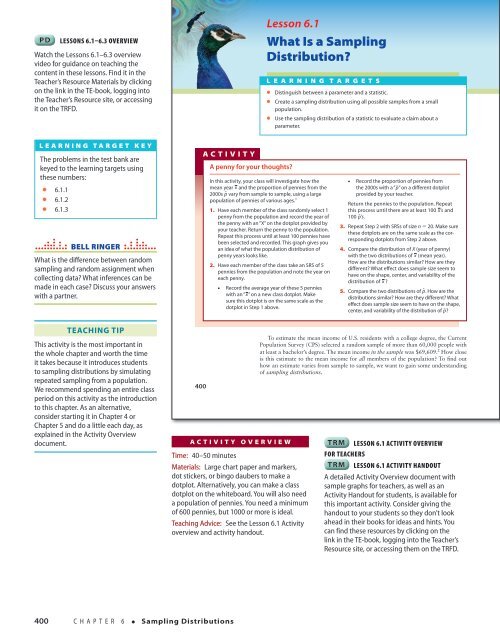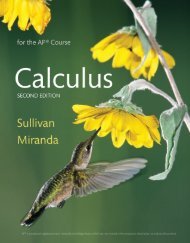SPA 3e_ Teachers Edition _ Ch 6
Create successful ePaper yourself
Turn your PDF publications into a flip-book with our unique Google optimized e-Paper software.
PD LESSONS 6.1–6.3 Overview<br />
Watch the Lessons 6.1–6.3 overview<br />
video for guidance on teaching the<br />
content in these lessons. Find it in the<br />
Teacher’s Resource Materials by clicking<br />
on the link in the TE-book, logging into<br />
the Teacher’s Resource site, or accessing<br />
it on the TRFD.<br />
Lesson 6.1<br />
What is a Sampling<br />
Distribution?<br />
L e A r n i n g T A r g e T S<br />
d Distinguish between a parameter and a statistic.<br />
d Create a sampling distribution using all possible samples from a small<br />
population.<br />
d Use the sampling distribution of a statistic to evaluate a claim about a<br />
parameter.<br />
Learning Target Key<br />
The problems in the test bank are<br />
keyed to the learning targets using<br />
these numbers:<br />
d 6.1.1<br />
d 6.1.2<br />
d 6.1.3<br />
BELL RINGER<br />
What is the difference between random<br />
sampling and random assignment when<br />
collecting data? What inferences can be<br />
made in each case? Discuss your answers<br />
with a partner.<br />
AcT iviT y<br />
A penny for your thoughts?<br />
In this activity, your class will investigate how the<br />
mean year x and the proportion of pennies from the<br />
2000s p^ vary from sample to sample, using a large<br />
population of pennies of various ages. 1<br />
1. Have each member of the class randomly select 1<br />
penny from the population and record the year of<br />
the penny with an “X” on the dotplot provided by<br />
your teacher. Return the penny to the population.<br />
Repeat this process until at least 100 pennies have<br />
been selected and recorded. This graph gives you<br />
an idea of what the population distribution of<br />
penny years looks like.<br />
2. Have each member of the class take an SRS of 5<br />
pennies from the population and note the year on<br />
each penny.<br />
• Record the average year of these 5 pennies<br />
with an “x” on a new class dotplot. Make<br />
sure this dotplot is on the same scale as the<br />
dotplot in Step 1 above.<br />
• Record the proportion of pennies from<br />
the 2000s with a “p^ ” on a different dotplot<br />
provided by your teacher.<br />
Return the pennies to the population. Repeat<br />
this process until there are at least 100 x's and<br />
100 p^'s.<br />
3. Repeat Step 2 with SRSs of size n 5 20. Make sure<br />
these dotplots are on the same scale as the corresponding<br />
dotplots from Step 2 above.<br />
4. Compare the distribution of X (year of penny)<br />
with the two distributions of x (mean year).<br />
How are the distributions similar? How are they<br />
different? What effect does sample size seem to<br />
have on the shape, center, and variability of the<br />
distribution of x ?<br />
5. Compare the two distributions of p^ . How are the<br />
distributions similar? How are they different? What<br />
effect does sample size seem to have on the shape,<br />
center, and variability of the distribution of p^ ?<br />
Teaching Tip<br />
This activity is the most important in<br />
the whole chapter and worth the time<br />
it takes because it introduces students<br />
to sampling distributions by simulating<br />
repeated sampling from a population.<br />
We recommend spending an entire class<br />
period on this activity as the introduction<br />
to this chapter. As an alternative,<br />
consider starting it in <strong>Ch</strong>apter 4 or<br />
<strong>Ch</strong>apter 5 and do a little each day, as<br />
explained in the Activity Overview<br />
document.<br />
400<br />
Starnes_<strong>3e</strong>_CH06_398-449_Final.indd 400<br />
Activity Overview<br />
Time: 40–50 minutes<br />
Materials: Large chart paper and markers,<br />
dot stickers, or bingo daubers to make a<br />
dotplot. Alternatively, you can make a class<br />
dotplot on the whiteboard. You will also need<br />
a population of pennies. You need a minimum<br />
of 600 pennies, but 1000 or more is ideal.<br />
Teaching Advice: See the Lesson 6.1 Activity<br />
overview and activity handout.<br />
To estimate the mean income of U.S. residents with a college degree, the Current<br />
Population Survey (CPS) selected a random sample of more than 60,000 people with<br />
at least a bachelor’s degree. The mean income in the sample was $69,609. 2 How close<br />
is this estimate to the mean income for all members of the population? To find out<br />
how an estimate varies from sample to sample, we want to gain some understanding<br />
of sampling distributions.<br />
TRM Lesson 6.1 Activity Overview<br />
for <strong>Teachers</strong><br />
TRM Lesson 6.1 Activity Handout<br />
A detailed Activity Overview document with<br />
sample graphs for teachers, as well as an<br />
Activity Handout for students, is available for<br />
this important activity. Consider giving the<br />
handout to your students so they don’t look<br />
ahead in their books for ideas and hints. You<br />
can find these resources by clicking on the<br />
link in the TE-book, logging into the Teacher’s<br />
Resource site, or accessing them on the TRFD.<br />
18/08/16 4:57 PMStarnes_<strong>3e</strong>_CH0<br />
400<br />
C H A P T E R 6 • Sampling Distributions<br />
Starnes_<strong>3e</strong>_ATE_CH06_398-449_v3.indd 400<br />
11/01/17 3:53 PM




